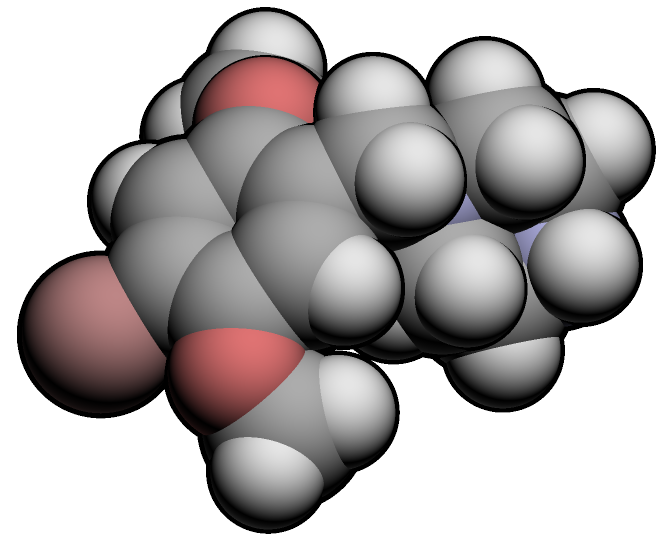Summary
4-Bromo-2,5-dimethoxy-1-benzylpiperazine (2C-B-BZP) is a psychoactive compound belonging to the piperazine chemical class, and it has been marketed as a “designer drug.” This substance induces stimulating effects that closely resemble those of benzylpiperazine (BZP).
| Identifiers | |
|---|---|
| IUPAC name | |
| CAS Number | 1094424-37-9 |
|---|---|
| ChemSpider | 26234933 |
| UNII | R0E29C6K2K |
| CompTox Dashboard (EPA) | DTXSID00148936 |
| Chemical and physical data | |
| Formula | C13H19BrN2O2 |
| Molar mass | 315.211 g·mol−1 |

Chemistry
2C-B-BZP comprises a benzylpiperazine core combined with the ring-substitution structure found in the psychedelic phenethylamine 2C-B. Notably, 2C-B-BZP doesn’t belong to the phenethylamine family itself and does not elicit psychedelic effects. This is due to the positioning of its binding groups, which are not conducive to activating the 5-HT2A receptor. Conversely, its phenylpiperazine counterpart, 2C-B-PP, can substitute for DOM in DOM-trained rats but with only about a tenth of the potency of DOM. However, it does not exhibit substitution properties for TFMPP.
Effects
2C-B-BZP induces stimulating effects that typically endure for a duration of 3 to 6 hours. According to multiple sources, it is believed to enhance the effects of other substances when used in combination. Users may experience side effects like headaches and nausea, which are akin to those associated with other piperazine derivatives commonly used for recreational purposes.

Legality
In the United States, 2C-B-BZP is currently unscheduled and unregulated. However, there is a potential for legal prosecution under the Federal Analog Act due to its structural resemblance to benzylpiperazine. It is worth noting that 2C-B-BZP is prohibited in Japan, where it was once available in local smart shops, making its possession, use, or sale illegal in that country.
FAQ
- What is 2C-B-BZP?
- 2C-B-BZP is a psychoactive drug and research chemical belonging to the piperazine chemical class. It is commonly categorized as a “designer drug.”
- What effects does 2C-B-BZP produce?
- 2C-B-BZP primarily produces stimulant effects, which can last for about 3 to 6 hours. Users may experience increased alertness and energy.
- Is 2C-B-BZP similar to benzylpiperazine (BZP)?
- Yes, 2C-B-BZP is structurally related to BZP, and it shares similar stimulant effects with BZP.
- Is 2C-B-BZP a psychedelic drug like 2C-B?
- No, 2C-B-BZP is not a psychedelic drug. Despite having structural similarities to the psychedelic compound 2C-B, it does not produce psychedelic effects.
- What are the side effects of 2C-B-BZP?
- Users have reported side effects such as headaches and nausea, which are familiar with other piperazine derivatives used recreationally.
- Is 2C-B-BZP legal in the United States?
- Currently, 2C-B-BZP is unscheduled and uncontrolled in the United States. However, it could be prosecuted under the Federal Analog Act due to its structural resemblance to benzylpiperazine.
- Is 2C-B-BZP legal in Japan?
- No, 2C-B-BZP is illegal in Japan. It was previously available in local smart shops but has since been prohibited, making its possession, use, or sale illegal in the country.
- Is 2C-B-BZP considered safe for consumption?
- The safety of 2C-B-BZP has yet to be extensively studied, and its use may carry risks. Like with any psychoactive substance, it’s crucial to exercise caution and be aware of potential side effects and legal regulations in your area.
- Can 2C-B-BZP be combined with other substances?
- Some sources suggest that 2C-B-BZP may increase the effects of other compounds when used together. However, combining substances can be unpredictable and may lead to adverse reactions. It is advisable to approach such combinations with caution.
- Where can I find more information about 2C-B-BZP?
- For the latest information on 2C-B-BZP, its legality, and potential risks, it is recommended to consult reliable sources, stay updated on relevant laws, and consider seeking guidance from healthcare professionals when necessary.
References
- Westphal F, Junge T, Girreser U, Stobbe S, Pérez SB (May 2009). “Structure elucidation of a new designer benzylpiperazine: 4-bromo-2,5-dimethoxybenzylpiperazine” – This study focused on identifying the structure of a novel designer benzylpiperazine known as 4-bromo-2,5-dimethoxybenzylpiperazine. The research contributes to our understanding of emerging designer drugs.
- Peters FT, Martinez-Ramirez JA (October 2010). “Analytical toxicology of emerging drugs of abuse” – This publication explores the field of analytical toxicology concerning emerging drugs of abuse. It provides insights into the detection and analysis of substances like designer drugs, shedding light on their pharmacological and toxicological aspects.
- Daniel Trachsel; David Lehmann & Christoph Enzensperger (2013). Phenethylamine: Von der Struktur zur Funktion. Nachtschatten Verlag AG. ISBN 978-3-03788-700-4 – This book, titled “Phenethylamine: Von der Struktur zur Funktion,” delves into the world of phenethylamines, including their structure and function. It serves as a comprehensive resource for those interested in the chemistry and pharmacology of this class of compounds.